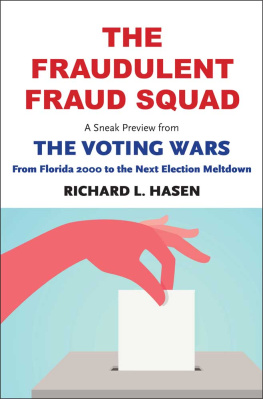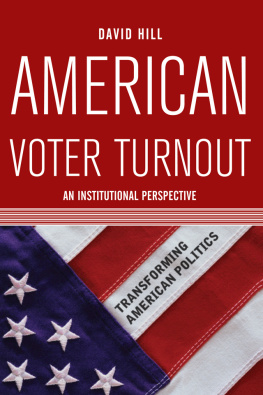
Published in 2021 by New York Times Educational Publishing in association with The Rosen Publishing Group, Inc.
29 East 21st Street, New York, NY 10010
Contains material from The New York Times and is reprinted by permission. Copyright 2021 The New York Times. All rights reserved.
Rosen Publishing materials copyright 2021 The Rosen Publishing Group, Inc. All rights reserved. Distributed exclusively by Rosen Publishing.
First Edition
The New York Times
Caroline Que: Editorial Director, Book Development
Cecilia Bohan: Photo Rights/Permissions Editor
Heidi Giovine: Administrative Manager
Rosen Publishing
Megan Kellerman: Managing Editor
Meredith Day: Editor
Brian Garvey: Art Director
Cataloging-in-Publication Data
Names: New York Times Company.
Title: Voter suppression: blocking the ballot box / edited by the New York Times editorial staff.
Description: New York: New York Times Educational Publishing, 2021. | Series: In the headlines | Includes glossary and index. Identifiers: ISBN 9781642824247 (library bound) | ISBN 9781642824230 (pbk.) | ISBN 9781642824254 (ebook) Subjects: LCSH: VotingUnited StatesJuvenile literature. | Voter registrationCorrupt practicesUnited StatesJuvenile literature. | ElectionsCorrupt practicesUnited StatesJuvenile literature. | Election lawUnited StatesJuvenile literature. | Suffrage United StatesJuvenile literature. | Race discrimination Political aspectsUnited StatesJuvenile literature. |
MinoritiesSuffrageUnited StatesJuvenile literature. Classification: LCC JK1846.V684 2021 | DDC 324.60973dc23
Manufactured in the United States of America
On the cover: A sign directing voters to have a photo ID in Arlington, Va., Nov. 4, 2014; Doug Mills/The New York Times.
Contents
Introduction
THE RIGHT TO VOTE is a hallmark of democracy it gives ordinary citizens the opportunity to choose who they want to represent their voice in government at all levels, from city council to president of the United States. But the reality of voting in the United States is much more complicated. Many surprising factors can affect who is able to cast a ballot on Election Day, long after some of the largest barriers to voting have been eliminated via federal law or amendment to the U.S. Constitution. Nationally, voters cannot be discriminated against for their sex or race; it is also illegal to require voters to pay a fee, or poll tax, in order to vote. But more subtle policies, many of which vary widely by state, can still make it difficult or impossible for someone to vote and often, the voters who are most affected continue to be poor or members of minority communities, just as they were in the past.
States may have different rules about how to register to vote, including how far in advance of the election people must register. A major source of contention is the identification that voters need to present at the polls: States with stricter regulations are placing a greater burden on people who are less likely to have a drivers license or other state ID, such as students and elderly people. Getting the ID could itself be an arduous process if a person cant get time off work to stand in line, cant afford to pay a registration fee or doesnt have the proper documentation to prove who they are. On Election Day, unless they are eligible for an absentee ballot or have vote-by-mail in their state, voters need to get to the appropriate polling place, which may not be nearby or open during convenient hours for their work schedule. People who have moved or havent voted in many years may find that local election officials have removed their name from the voting rolls. All of these barriers to voting can be discouraging and lead to lower voter turnout.

PATRICK DODSON FOR THE NEW YORK TIMES
Poll workers at a training session in Albany, N.Y., learn about the new voting technology that became a part of the states early voting process in October 2019.
On the other hand, its important to make sure that only eligible voters are participating. Like voter suppression, voter fraud has a long history. The most legendary example is in Chicago, where a 1983 Chicago Tribune investigation of one million votes found that 10 percent of them were fraudulent. The Democratic party machine in the city coordinated to cast ballots for thousands of dead people who were still on active lists of registered voters. But studies have consistently shown that in-person voter fraud is extremely rare: There is little risk of the same person voting multiple times or impersonating another voter at the polls.
In recent years, the debate about voter suppression versus voter fraud has been highly polarized. Democrats argue that voter-suppression tactics unfairly target disadvantaged groups: African-Americans,
Hispanics, impoverished neighborhoods, disabled people, elderly people and so on. Because of this, Democrats advocate for making voting easier and more available to all who are eligible through early voting periods, automatic voter registration and more flexible ID requirements. Meanwhile, Republicans maintain that strict regulations on voting, such as voter ID laws, are necessary to combat voter fraud and do not constitute an undue burden on voters. As both parties compete for votes and try to turn out people on their side, they may see an advantage in discouraging people who disagree with them from participating.
In the 2016 presidential race, Donald J. Trump forcefully argued that voter fraud was a serious and rampant problem, a charge he continued to make during his presidency despite a lack of evidence for it. Voters also began to fear that their votes would not be fairly counted after evidence emerged that Russia had conducted a targeted campaign to interfere in the 2016 presidential election a troubling threat that remained throughout the 2018 midterm elections and in the lead-up to the 2020 race. The articles compiled here describe the various forms that voter suppression takes, as well as the efforts to combat it and ensure every eligible voter can exercise their rights.
CHAPTER 1
Groups Targeted by Voter Suppression
Historically, voter suppression tactics have focused on African-Americans. The Voting Rights Act of 1965 outlawed many of these tactics, but black, Hispanic, Native American and other minority voters are still often targeted. Other groups face obstacles as well, such as disabled voters who cant get to the polls. Also, college students often struggle to vote if their student IDs arent considered an acceptable form of voter identification. Another question is when or whether to allow convicted felons to vote after they have completed their sentence.
16 Years After Bush v. Gore, Still Wrestling With Ballot-Box Rules
RETRO REPORT | BY CLYDE HABERMAN | FEB. 21, 2016
Retro Report re-examines the leading stories of decades past through essays and video documentaries.
REFLECTING ON BASEBALL ATTENDANCE, the philosopher Yogi Berra observed that if people dont want to come to the ballpark, how are you going to stop them? He could have said much the same thing about the American electorate. If voters dont want to go to the polls, what is going to stop them, too? Often enough, nothing has.
Across the decades, Americans have chosen not to exercise the franchise aerobically. The turnout rate in national elections, typically below 60 percent, ranks near the bottom among the worlds developed democracies. The share of Americans who even bother registering to vote 64.6 percent, according to the most recent figures from the United States Census Bureau does not come close to rates exceeding 90 percent in Western Europe and Canada. Even in a supposedly banner year like 2008, when Barack Obamas candidacy generated plenty of excitement, the turnout was not quite 62 percent, a pace that countries like Belgium, Denmark and Sweden would regard as dismal.
Next page


















